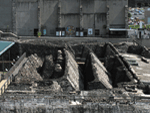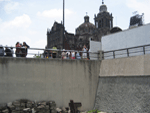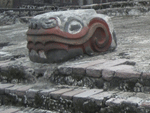Source: These images were taken by WTL© (2009) at the Templo Mayor in Mexico City.
Comments: The Templo Mayor (Spanish for Great Temple) is the principal sacred site of the Aztec empire in their capital city of Tenochtitlán. The archeological site in Mexico City is found at the corner of these streets in the historical heart of the city: Calle Seminario (which runs along the southern side of the Catholic Cathedral) and Calle Justo Sierra (1848-1912), named for a great Mexican intellectual. What you will see in this series of photographs are the ruins in the archeological site. It was constructed by the Mexica-Aztecs in the Postclassic period (after 1200 C.E.). In Náhuatl, it was called the huey teocalli, and given Mesoamerican dualistic organizing principle, it was dedicated to two gods: Huitzilopochhtli (war) and Tláloc (rain). At its peak, it measured 330 ft. by 260 ft. The top of its twin temples was about a hundred feet high. You will see modern models of it in the Sacred Precinct in both visual tour of the Museo de Antropología and the Museo del Templo Mayor. Construction of the huey teocalli was begun between 1326 and 1390 C.E.; that is, late in the Postclassic Period, and it was enlarged six more times (total stages = 7). The ruins we see in the archeological site are due to the Spanish conquistadors' destruction of the Templo Mayor after 1521. As you can see, this series of images begins with a bird's eye view of the site and ends with a photo taken inside the site showing the relationship between the Templo Mayor and the Cathedral.
Humanities topics: (1) Explain the specificity of the year 1326 C.E. in relation to the Aztec empire. (2) State three principles you take from these ten thumbnail images that are unique to Latin American humanities (see: => Latin American Themes)





